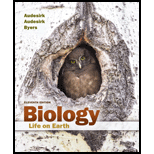
A factor that increases humanity's ecological footprint is
a. human population growth.
b. technological innovations that improve the efficiency with which
c. renewable energy sources.
d. sustainable agriculture.
Introduction:
The estimate of regions of the earth engaged in the production of resources for human beings and the absorption of wastes produced by human beings is described as the human ecological footprint. The available capacity for waste absorption and resource production on the earth is defined as biocapacity. The present situation of the earth shows that the human ecological footprint has exceeded biocapacity. In case conservation of resources is not entertained, then living beings will soon run out of natural resources.
Answer to Problem 1MC
Correct answer:
A factor that increases humanity’s ecological footprint is human population growth.
Explanation of Solution
Explanation for the correct answer:
Option (a) is given that a factor that increases humanity’s ecological footprint is human population growth. It is true because natural resources are used up very fast by increasing population to fulfill their needs. The requirement of natural resources increases with increasing population. This causes overexploitation of ecosystems. Hence, option (a) is correct.
Explanation for incorrect answers:
Option (b) is given that a factor that increases humanity’s ecological footprint is technological innovations that improve the efficiency, with which resources are used. All kinds of technologies are invented by human beings. The main issue of increasing human ecological footprint is increasing the population. So, it is an incorrect option.
Option (c) is given that a factor that increases humanity’s ecological footprint is renewable energy resources. These resources include tidal, solar, geothermal, hydro and wind energy. Renewable natural resources help in conservation of biodiversity and ecosystem. So, it is an incorrect option.
Option (d) is given that a factor that increases humanity’s ecological footprint is sustainable agriculture. Sustainable agriculture is done in order to protect the nature along with fulfilling the human needs. So, it is an incorrect option.
Hence, options (b), (c), and (d) are incorrect.
Therefore, it can be concluded that human population growth is a factor that increases humanity’s ecological footprint.
Want to see more full solutions like this?
Chapter 31 Solutions
Biology: Life on Earth (11th Edition)
- Molecular Biology Explain/discuss how “slow stop” and “quick/fast stop” mutants wereused to identify different protein involved in DNA replication in E. coli.arrow_forwardMolecular Biology Question A gene that codes for a protein was removed from a eukaryotic cell and inserted into a prokaryotic cell. Although the gene was successfully transcribed and translated, it produced a different protein than it produced in the eukaryotic cell. What is the most likely explanation?arrow_forwardMolecular Biology LIST three characteristics of origins of replicationarrow_forward
- Molecular Biology Question Please help. Thank you For E coli DNA polymerase III, give the structure and function of the b-clamp sub-complex. Describe how the structure of this sub-complex is important for it’s function.arrow_forwardMolecular Biology LIST three characteristics of DNA Polymerasesarrow_forwardMolecular Biology RNA polymerase core enzyme structure contains what subunits? To form holo enzyme, sigma factor is added to core. What is the name of the structure formed? Give the detailed structure of sigma factor and the function of eachdomain. Please help. Thank youarrow_forward
- Molecular Biology You have a single bacterial cell whose DNA is labelled with radioactiveC14. After 5 rounds of cell division, how may cells will contain radioactive DNA? Please help. Thank youarrow_forward1. Explain the structure and properties of atoms and chemical bonds (especially how they relate to DNA and proteins). Also add some pictures.arrow_forward1. In the Sentinel Cell DNA integrity is preserved through nanoscopic helicase-coordinated repair, while lipids in the membrane are fortified to resist environmental mutagens. also provide pictures for this question.arrow_forward
- Explain the structure and properties of atoms and chemical bonds (especially how they relate to DNA and proteins). Also add some pictures.arrow_forwardIn the Sentinel Cell DNA integrity is preserved through nanoscopic helicase-coordinated repair, while lipids in the membrane are fortified to resist environmental mutagens. also provide pictures for this question.arrow_forward1. Explain how genetic information is stored, copied, transferred, and expressed. Also add some pictures for this question.arrow_forward
 Concepts of BiologyBiologyISBN:9781938168116Author:Samantha Fowler, Rebecca Roush, James WisePublisher:OpenStax CollegeUnderstanding Health Insurance: A Guide to Billin...Health & NutritionISBN:9781337679480Author:GREENPublisher:Cengage
Concepts of BiologyBiologyISBN:9781938168116Author:Samantha Fowler, Rebecca Roush, James WisePublisher:OpenStax CollegeUnderstanding Health Insurance: A Guide to Billin...Health & NutritionISBN:9781337679480Author:GREENPublisher:Cengage Human Biology (MindTap Course List)BiologyISBN:9781305112100Author:Cecie Starr, Beverly McMillanPublisher:Cengage Learning
Human Biology (MindTap Course List)BiologyISBN:9781305112100Author:Cecie Starr, Beverly McMillanPublisher:Cengage Learning Comprehensive Medical Assisting: Administrative a...NursingISBN:9781305964792Author:Wilburta Q. Lindh, Carol D. Tamparo, Barbara M. Dahl, Julie Morris, Cindy CorreaPublisher:Cengage Learning
Comprehensive Medical Assisting: Administrative a...NursingISBN:9781305964792Author:Wilburta Q. Lindh, Carol D. Tamparo, Barbara M. Dahl, Julie Morris, Cindy CorreaPublisher:Cengage Learning Biology (MindTap Course List)BiologyISBN:9781337392938Author:Eldra Solomon, Charles Martin, Diana W. Martin, Linda R. BergPublisher:Cengage Learning
Biology (MindTap Course List)BiologyISBN:9781337392938Author:Eldra Solomon, Charles Martin, Diana W. Martin, Linda R. BergPublisher:Cengage Learning





